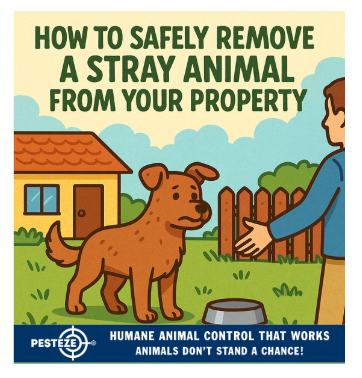HOW TO SAFELY REMOVE A STRAY ANIMAL FROM YOUR PROPERTY

HOW TO SAFELY REMOVE A STRAY ANIMAL FROM YOUR PROPERTY
SUMMARY
Stray animals may appear in your yard or near your home looking for food or shelter. While they might not seem dangerous, strays can carry diseases or become aggressive if threatened. This guide explains how to remove them safely and humanely.
FEATURES
-
Stay calm and observant: Avoid sudden movements or loud noises.
-
Do not touch directly: Strays may bite or scratch if approached.
-
Remove food and shelter: Eliminate attractants to encourage them to leave.
-
Guide gently: Use open exits or barriers to steer them away.
-
Use humane traps if needed: Safe for temporary capture and relocation.
-
Call professionals: Contact animal control or rescue services for assistance.
GUIDE DESCRIPTION
Stray animals are a common sight in neighborhoods, ranging from lost pets to abandoned or feral animals. While some may seem friendly, others can be fearful, stressed, or aggressive. Knowing how to safely remove a stray animal from your property ensures the well-being of both you and the animal.
The first step is to stay calm and observant. Watch the animal from a safe distance to assess its behavior. Avoid chasing, cornering, or startling the animal, as this can provoke defensive aggression. Keeping pets and children indoors will also reduce risks.
Never touch or attempt to pick up the stray. Even seemingly docile cats or dogs may bite or scratch when frightened. Strays may carry fleas, ticks, or diseases like rabies, so it’s best to keep physical contact to a minimum.
Next, remove food and shelter sources. Strays are often drawn to easy meals or comfortable hiding places. Secure garbage cans with tight lids, bring pet food indoors, and block access to sheds, crawl spaces, or porches. Without access to these attractants, many strays will leave on their own.
If the animal doesn’t move on, try to guide it gently. Open a gate, create a clear path to the street, or use calm movements and barriers (like a broom held at a distance) to direct the animal outward. The goal is to encourage the stray to leave voluntarily without causing stress or harm.
For persistent cases, consider using a humane trap. These traps, available from local shelters or animal control, allow safe capture without injury. Once caught, the animal can be evaluated for identification, vaccinations, or rehoming.
When necessary, always contact professionals. Local animal control officers, rescue groups, or humane societies are trained to handle strays safely. They can check for microchips, provide medical care, and help the animal find an appropriate home or safe relocation.
By staying calm, avoiding direct contact, and involving professionals, you can resolve stray animal encounters in a safe and humane way while contributing to the overall health and safety of your community.
- Saneeth Thota


Comments 0